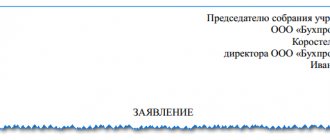Kontur.Accounting is a web service for small businesses!
Quick establishment of primary accounts, automatic tax calculation, online reporting, electronic document management, free updates and technical support.
Try it
Any organization must ensure systematization, integrity, safety of documents and convenient access to them. To do this, the documents are stitched. This activity requires accuracy and attentiveness. We’ll tell you how to staple documents and what you need for this in our article.
Basic rules governing the process of document stapling:
- Methodological recommendations approved by Order of the Federal Archive of December 23, 2009 No. 76;
- GOST R 51141 - 98 “Office management and archiving”;
- Recordkeeping requirements developed by industry departments.
If documents are stitched incorrectly
- Incorrect firmware of documents may be a reason for refusal to accept them. And this is wasted time, effort and money down the drain.
- Incorrect or poor-quality firmware of your organization’s documents may serve as a reason for interested parties to refuse to cooperate.
- If the documents are not carefully stitched, then there is a high probability that they will be disorganized or even replaced, which will be very difficult to prove during future verification.
And these are just some of the problems that can be encountered when documents are inserted incorrectly.
Use of machines
Machines for storing (stitching) documentation are special devices that have a wooden frame at the base. Most often the frame is made of beech or oak. Accordingly, the cost of such an archival product is quite high (about 1,500 rubles per unit).
Each machine is equipped with a special side ruler for aligning sheets and a clamping bar that ensures reliable fixation. The thickness of the firmware, depending on the machine model, can be up to 5-8 centimeters.
This device is equipped with a handle that makes it easier to transport documents inside the archive. The machine is one of the best solutions for storing archival files.
Before packing the document, it is recommended to place a special cardboard for packaging on the frame, which will act as a binding.
What documents need to be stapled and why?
Documents are stapled to ensure they are not lost or replaced.
Also, documents undergo firmware due to the large flow of documentation, so as not to get confused in business papers. Typically, those documents that are submitted to archives, sent for inspection, or have some value for their owner are subject to stitching.
Documents that must be stapled:
- archival;
- accounting;
- personnel;
- For checking.
The exception is documents for the tax service.
There is no need to sew them together, since tax officials repeatedly have to dismantle them for scanning and other manipulations. Important!
The clerk must remember the accuracy and quality of stitching. Otherwise, if the documents are disbanded or if they are lost, all responsibility will fall on his shoulders.
Regulatory acts
The regulatory framework that today regulates the procedure for flashing documentation is very broad, however, most of the regulations have not been updated for a long time.
Thus, the main act that regulates the process of firmware documentation is the order of the Ministry of the Russian Federation for Taxes and Duties dated April 18, 2003, containing general instructions for filling out certain types of papers, including their firmware.
In addition to this document, the following regulations can be distinguished:
- GOST R 51141-98 “Office management and archiving. Terms and Definitions".
- Order of the Federal Tax Service of January 25, 2012 N ММВ-7-6/25. According to this order, the mandatory binding of documentation when submitting documents for registration of an organization or individual entrepreneur is canceled, however, the Federal Tax Service still prefers to accept stitched sheets.
Video - how to file things correctly:
Firmware documentation in some areas of activity is regulated by separate regulations of the organizations responsible for the area. Thus, firmware in the banking sector is regulated by the Instruction of the Central Bank of the Russian Federation “On office work in the Central Bank of the Russian Federation.”
Preparing documents for stapling
Before starting the main work, documents must be prepared. The preparation process takes place in several stages:
1. Cover design.
Covers for documentation come in three types:
- Standard – the usual cover that is most often found. Cover size 229x324 mm, accommodates standard sheets (mostly A4).
- Non-standard – used if the document format is of an unusual size.
- For long-term storage - these covers are made of durable cardboard for longer storage. They must be dense and wear-resistant.
2. Equipment.
We are preparing a set of documents. The pack should contain no more than 250 sheets. Its thickness should be no more than 4 cm. A blank sheet must be added to the block. All paper clips and pins must be removed.
3. Numbering.
Page numbering is done only with a simple pencil. The number is placed in the upper right corner. No Roman notation. The inventory is not included in the numbering. Page numbers should not affect the text of the document.
Important!
In the process of numbering with the title page, the number “1” is not placed; we number only from the second sheet with the number “2”. Basic instructions:
- If the documentation contains a large format sheet, it must be unfolded and numbered in the upper right corner, then folded in the same way. It is hemmed neatly, at one edge, so that it can be unfolded several times.
- In documents, letters are stored in envelopes. First, number the envelope, then all the letters enclosed in it.
- If the volume of documentation is too large (more than 250 sheets), then it is divided into volumes that have their own separate numbering.
- Sometimes documents contain separately numbered editions. They are also numbered, despite the existing numbering.
- If the documentation contains glued sheets, then this document must be numbered as one. Next, an inventory of the attached additions is compiled on the reverse side of this sheet.
- When the sheet is completely occupied and there is no room for numbering, they are numbered on the back of the document.
- If the numbering is incorrect, the number is crossed out and the correct one is added, and a certification inscription must be made on the corrected section.
4. Inventory.
Each bound document must have its own inventory, in which you must indicate:
- organization and title of the document;
- date of filing and shelf life;
- detailed annotation (purpose of storage, content, number of pages and other important notes);
- number of documents and signature indicating full name.
Note!
Documents intended for internal use are stapled according to the rules established by your organization.
Designing the cover
As you know, theater begins with the wardrobe, and business begins with the cover. The first thing to do is choose a cardboard cover for the case. Although at first glance it seems that they are all the same, this is not entirely true. There are three types: standard, non-standard and cover for long-term storage :
- Standard ones are most common; their size is 229x324 millimeters. They are used when the sheets have a regular, standard size.
- Non-standard differs in size and is needed when a document for some reason has a specific, non-standard size.
- And the last type is a document that, according to legal regulations, must be stored in an archive for more than 25 years. It requires a hard cardboard cover. Since the storage period is quite long, care should be taken to ensure that the document is in proper form and is suitable for use after such a period of time. Acid-free cardboard covers are used for those documents that are subject to submission to the state archive.
You can view the rules and a sample of filling out a payroll slip using the T-49 form in this article.
If you are interested in what OKATO is, check out this material.
Possible stitching options
There are many ways to bind documentation. It all depends on the available equipment and management requirements. Here are some options:
- The classic method is using a needle and thread. Usually a small volume of documents is stitched using two, three or five punctures. The threads are fastened together and a certification inscription is glued to them.
- Using a screwdriver and tight rope. Suitable for bulky materials.
- Using a hole punch. Similar to the classic method, only instead of a needle there is a hole punch.
- Using a binding machine. This type of stitching is used only in printing houses.
3.6. requirements for registration of cases accepted into the archive
When the stitching is completed, the needle and thread are inserted into the central hole and brought out to the back of the assembled documents. The remaining end of the thread must be tied in a knot. The documentation is sewn together with bank twine, thin Mylar tape or stitching threads. How to sew documentation with thread Preparing accessories:
- needles and thread of suitable thickness
- documents that need to be flashed
- an awl or other tool for making holes in paper
- organization seal
- stationery glue
We stitch the document in 3 stages:
- We are preparing papers for stitching.
Document binding process
We remove all brackets, paper clips, number them, put them in an even pile and begin stitching:
1. Make 3 holes (punctures) in the documents with a needle (if necessary, with an awl). The distance between the holes is about 3 cm. The thread is 80 cm long.
Note!
Regular threads can be fragile, it is better to use thicker and stronger ones. As a last resort, you should fold the thread two or three times. 2. We thread the needle from the wrong side into the middle hole.
3. Then immediately stick the needle into the top hole.
4. After the top puncture, we stick it through the wrong side into the bottom hole.
5. Next, coming out of the lower hole, we pass into the middle one. If you need to stitch a large number of cases, then repeat the stitching process several times to strengthen the folder.
6. Tie a simple knot on the wrong side.
There should be a thread tail of about eight centimeters left. 7. We glue a certification sheet onto the bundle, on which we make the necessary entry. The sticker with the certification inscription usually measures 4x6 cm. The sheet is glued to the knot and part of the threads.
Note!
The documents must be certified by the head of the organization or his authorized representative.
8. We put a stamp and signature.
Important!
When certifying bound documents with a signature and seal, place them so that part is on both the sticker and the document being certified. This will guarantee the safety and integrity of documents.
How to arrange an archival binding of a case?
Form for internal inventory of case documents In cases with long storage periods, you can stitch the case through and through, including both the top and bottom of the cover. Cases with a permanent shelf life are filed, starting with the sheet following the cover. The top part of the cover is not hemmed. A thin cardboard spacer, up to 1 cm wide, is placed on the first sheet, and the case is stitched through it.
Since such a case is supposed to be stored forever, such a filing protects the threads from abrasion and gives a more aesthetic appearance to the case. When filing, you must make sure that all the text of the documents can be read. Documents with a shelf life of less than 10 years may not be filed, but remain in a folder.
All sheets in permanent and temporary storage files are numbered to ensure the safety of documents and ease of use.
Free legal advice online
The involvement of lawyers in legal disputes is due to the need to fully protect the personal interests of citizens. As practice shows, citizens avoid legal assistance in order to save money, but in practice this is associated with high costs. Even citizens with a lawyer's education do not always keep up with current changes in legislation, so it would be advisable to consult a qualified specialist.
The convenience is that consultation with a lawyer is free and online. Where and how to get free legal advice? is provided throughout the Russian Federation.
Citizens, residents of the state, as well as non-residents of the country who temporarily reside in the Russian Federation can take advantage of the support.
Moreover, lawyers can advise interested parties outside Russia, but only within the framework of domestic legislation.
Legal advice is provided free of charge online around the clock, regardless of weekends and holidays. The response time from specialists on the website is up to 15 minutes. There is no need to register on the Internet portal and you can send a personal appeal anonymously.
Attention! The online lawyer provides answers to questions and continues to support the client in the event of further difficulties. Legal advice can be obtained in the following ways:
- call the hotline.
- draw up a contact form for the feedback service;
- use the online chat service;
Online legal consultation can also be carried out via email. The advantages of the services of our law firm are due to the professional attitude of our specialists to their work, the receipt of regular training courses, as well as participation in official forums.
This ensures that individuals and businesses can receive advice that complies with current legal provisions. Certificates are provided
Tips for convenience
If straight edges of the holes are of fundamental importance to you, take a hole punch. But remember that too many sheets are too much for him. Make sure that all three holes are evenly spaced in height and spaced approximately 3 cm apart from each other. The middle one should fall in the middle of the page.
To prevent damage to the title page and the collapse of the case, it is often recommended to reinforce the stitching area at the front and back with strips of cardboard. A thread will be passed through it. Its usual size is 70 cm. But in each specific case it depends on the thickness of the stack.
Results
Companies and individual entrepreneurs are required to maintain a cash book (it doesn’t matter whether they use old-style cash registers or online cash registers).
The cash book, drawn up in paper form (in the form of a finished journal), must be numbered and stitched correctly before filling it out, making a record of the number of stitched sheets and verifying it with the signatures of the manager and the chief accountant.
If the cash book is maintained on a computer (for example, in the 1C:Enterprise program), its sheets are printed at the end of the day in which entries in the cash book were made, and stitched together as they accumulate or at the end of the year.
A digitally certified cash book produced in electronic form does not require printing or stapling.
You can find more complete information on the topic in ConsultantPlus. Free trial access to the system for 2 days.
Inventory - the head of everything
Each separately bound set of documents must be supplied with an inventory, which must contain certain information, namely:
- Title of the document;
- date of compilation of the inventory;
- title and abstract (it explains for what purposes this set of documentation is needed);
- listing of all documents available in the binder (for each the number of sheets is indicated);
- surname, position and signature of the responsible person - the compiler of the inventory.
The inventory is not subject to numbering and may look like this:
Closed joint stock company
"East"
St. Petersburg 00.00.0000
List of documents
| N p/p | Document date | Document title | Sheet numbers | Number of sheets | Note |
| 1 | |||||
| 2 | |||||
| 3 |
Total ______________________________________________ documents.
(in numbers and words)
Clerk ____________________ Petrova A.I.






